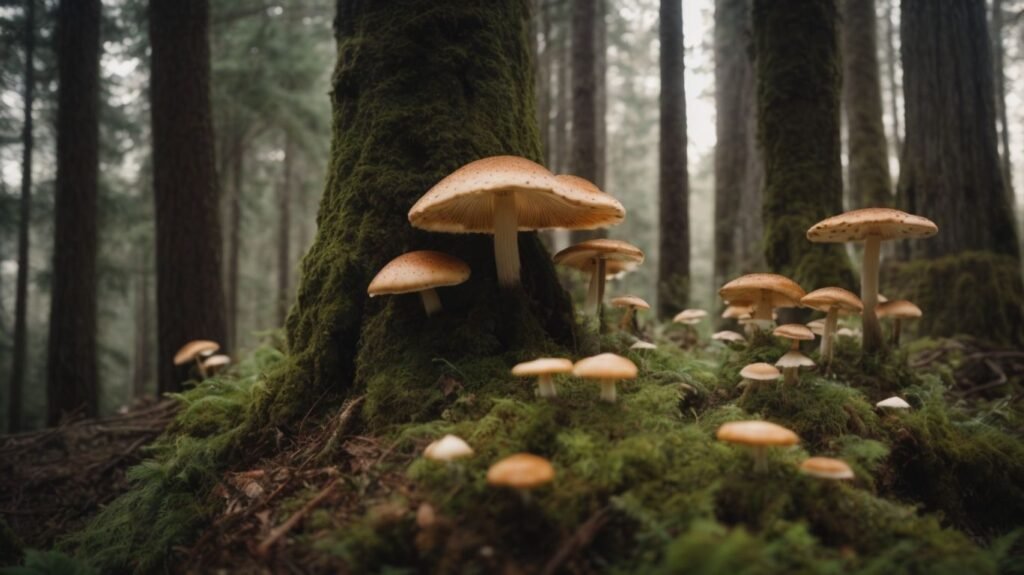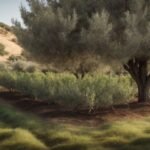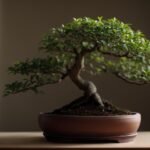Fungi And Forestry Cultivating
Are you curious about the fascinating relationship between fungi and forestry?
Learn about the innovative method of cultivating mushrooms on tree trunks, including the types of trees suitable for mushroom cultivation, the steps involved, and the benefits of growing mushrooms in this way.
This method offers a unique and eco-friendly approach to mushroom cultivation, promoting sustainability, biodiversity, and the use of unused resources.
Stay tuned to discover the types of mushrooms that can be grown, the ideal conditions for success, and the common challenges faced in this intriguing practice.
What Are Fungi and Forestry?
Fungi play a crucial role in the ecosystem, especially within the context of forestry. Forestry involves the sustainable management of forests for various purposes, including timber production, conservation, and ecosystem services.
Fungi act as decomposers, breaking down organic matter like fallen leaves and dead trees, recycling nutrients back into the soil. This process helps in nutrient cycling and maintaining soil fertility, which is vital for the growth of trees and other plant species in forests.
Certain fungi form symbiotic relationships with tree roots, aiding in nutrient uptake and enhancing the overall resilience of forest ecosystems. Understanding fungal diversity and their interactions with trees is essential for ensuring the health and productivity of forests in sustainable forestry practices.
How Are Mushrooms Cultivated on Tree Trunks?
Cultivating mushrooms on tree trunks involves the inoculation of logs with mushroom spawn to encourage mycelium growth and fruiting. This cultivation method utilizes tree trunks as a sustainable medium for mushroom production.
- The process of log cultivation for mushrooms begins with selecting healthy hardwood logs, such as oak or maple, that are around 3 to 6 feet long and 4 to 6 inches in diameter.
- These logs are then inoculated by drilling holes and inserting spawn plugs or sawdust spawn.
- Over time, the mycelial network develops within the logs, breaking down the wood fibers and converting nutrients into a substrate suitable for mushroom growth.
- Harvesting typically occurs when mushrooms are ready to be picked, ensuring a continuous cycle of production.
Different cultivation methods, like stack-and-shock or totem methods, offer varying levels of environmental impact on forest ecosystems, influencing factors such as biodiversity, carbon sequestration, and long-term sustainability.
What Types of Trees Can Be Used for Mushroom Cultivation?
Various tree species can be utilized for mushroom cultivation on tree trunks, ranging from hardwoods like oak and maple to conifers such as pine and spruce. Log culture in diverse woodlands enhances tree trunk biodiversity and supports fungal diversity.
This biodiversity in tree trunks is crucial for promoting the growth of a wide range of mushroom species. Different fungi have specific preferences for the type of trees they colonize, with some favoring hardwoods while others thrive on conifers. By cultivating mushrooms on a variety of tree species, a rich ecosystem of fungi can be established. This not only boosts the overall biodiversity of the woodland but also contributes to sustainable mushroom production by ensuring a continuous supply of diverse mushroom species.
What Are the Steps for Cultivating Mushrooms on Tree Trunks?
The cultivation process of mushrooms on tree trunks involves several key steps, including log selection, inoculation with mushroom spawn, mycelium colonization, and eventual fruiting of mushroom species like shiitake, oyster, and reishi.
To start with, selecting suitable logs for mushroom cultivation is crucial; hardwood logs from trees like oak or maple are often preferred due to their density and ability to support mycelium growth. Once logs are chosen, the next step is to inoculate them with mushroom spawn by drilling holes in the log and inserting the spawn plugs. Mycelium growth must then be monitored closely, ensuring proper environmental conditions like humidity and temperature are maintained to support healthy growth. When the mycelium has colonized the logs, mushrooms can be harvested by gently twisting or cutting them, depending on the species.
What Are the Benefits of Growing Mushrooms on Tree Trunks?
Growing mushrooms on tree trunks offers a range of benefits, including promoting environmental sustainability, enhancing biodiversity in forest ecosystems, and providing valuable non-timber forest products that support natural resource management.
Mushroom cultivation on tree trunks not only helps in recycling nutrients and utilizing organic waste effectively but also reduces the reliance on traditional timber extraction, thus lowering deforestation rates. By utilizing tree trunks as a substrate for mushroom growth, we are tapping into a renewable resource without causing harm to the forest ecosystem. This sustainable practice not only contributes to the conservation of biodiversity but also plays a vital role in maintaining the balance of ecosystem services, such as carbon sequestration and soil health.
Sustainable and Eco-Friendly
One of the key benefits of growing mushrooms on tree trunks is the promotion of sustainable and eco-friendly practices in forest management. This cultivation method contributes to ecological restoration efforts and supports a balanced forest ecosystem.
By utilizing dead or dying tree trunks as a substrate for mushroom growth, not only are valuable resources being recycled effectively, but it also aids in enhancing biodiversity within the forest.
The mushrooms help break down the decaying wood, releasing nutrients back into the soil and creating a healthier environment for other plant species to thrive. This process mimics natural decomposition cycles, ultimately leading to improved soil quality and long-term forest resilience.
Increases Biodiversity
Growing mushrooms on tree trunks increases biodiversity within the forest ecosystem, fostering mycorrhizal interactions and symbiotic relationships between fungi and trees. This enhanced biodiversity contributes to the overall health of the forest ecosystem.
Mushrooms play a crucial role in nutrient cycling, breaking down organic matter and transferring nutrients to trees through their mycelium networks. This process not only benefits individual trees but also supports the entire forest community. The mycorrhizal associations between fungi and tree roots improve the trees’ ability to absorb water and essential minerals from the soil, enhancing their resilience to environmental stresses such as drought and disease outbreaks. These intricate relationships highlight the interconnectedness of all living organisms within the forest ecosystem.
Utilizes Unused Resources
Growing mushrooms on tree trunks utilizes unused resources such as logs and organic matter, contributing to nutrient cycling and enhancing the decomposition process in forest ecosystems. This cultivation method optimizes resource utilization and supports forest productivity.
By harnessing the natural ability of mushrooms to break down complex organic compounds, the cultivation process aids in recycling nutrients trapped in dead wood back into the ecosystem. By effectively utilizing tree trunks as substrates for mushroom growth, the overall health of the forest is enhanced as vital nutrients are released and made available for other plant and microbial communities. This symbiotic relationship between fungi and tree trunks plays a crucial role in maintaining the balance of nutrients and promoting biodiversity within forest ecosystems.
What Are the Different Types of Mushrooms That Can Be Grown on Tree Trunks?
Several types of mushrooms can be successfully grown on tree trunks, including popular varieties like shiitake, oyster, and reishi. These mushroom species offer unique flavors, textures, and nutritional benefits.
Shiitake mushrooms, for example, are known for their rich, umami flavor profile, making them a favorite in Asian cuisine.
Oyster mushrooms have a delicate texture and mild taste, making them versatile for various dishes.
Reishi mushrooms, on the other hand, are valued for their potential health benefits and adaptogenic properties.
Other common varieties like lion’s mane and maitake also bring distinct characteristics to the table, adding diversity to culinary creations and providing a range of flavors for mushroom enthusiasts to explore.
Shiitake Mushrooms
Shiitake mushrooms are a popular choice for cultivation on tree trunks due to their rich umami flavor and versatile culinary applications. The cultivation of shiitake mushrooms contributes to the dynamics of forest ecosystems and supports forest protection efforts.
Their growth on decaying wood helps in nutrient cycling, breaking down organic matter and recycling nutrients back into the ecosystem. This, in turn, enhances soil fertility and promotes overall forest health.
The process of shiitake cultivation on tree trunks mimics natural forest processes, encouraging biodiversity and maintaining ecosystem balance. By integrating shiitake cultivation into forest management practices, not only are delicious culinary ingredients produced, but a harmonious relationship between humans and forests is nurtured.
Oyster Mushrooms
Oyster mushrooms are prized for their delicate texture and mild flavor, making them a sought-after choice for cultivation on tree trunks. The cultivation of oyster mushrooms contributes to improving forest soil health and enhancing the mycorrhizal network in forest ecosystems.
Their cultivation not only provides a sustainable source of nutritious food but also plays a crucial role in the ecosystem. Oyster mushrooms help break down organic matter, recycling nutrients back into the soil. This process enriches the forest floor, promoting diverse plant growth and supporting a healthier environment for other organisms. The mycelium of oyster mushrooms forms beneficial mycorrhizal associations with plant roots, enhancing nutrient uptake and overall ecosystem resilience. By cultivating oyster mushrooms, individuals can actively contribute to the preservation and enhancement of forest biodiversity.
Reishi Mushrooms
Reishi mushrooms, known for their medicinal properties and unique appearance, are cultivated on tree trunks for their health benefits and culinary uses. Reishi cultivation supports forest canopy cover and enhances fungal diversity in forest ecosystems.
These mushrooms play a crucial role in maintaining biodiversity by providing habitat and nourishment for various organisms within the forest ecosystem. As natural decomposers, reishi mushrooms break down organic matter, contributing to soil health and nutrient cycling. Their presence also fosters a symbiotic relationship with trees, aiding in their growth and resilience. This interconnectedness promotes a balanced ecosystem where different species thrive, ultimately contributing to the overall health and sustainability of forest environments.
Lion’s Mane Mushrooms
Lion’s Mane mushrooms, known for their unique appearance and neurological benefits, are cultivated on tree trunks to support brain health and cognitive functioning. The cultivation of Lion’s Mane mushrooms aids in the natural tree decay process and promotes the growth of beneficial fungi in forest ecosystems.
This symbiotic relationship between Lion’s Mane mushrooms and trees is crucial for the overall health of forests, as it helps in breaking down organic matter and recycling nutrients. By colonizing tree trunks, these mushrooms play a vital role in decomposing dead wood, which is essential for maintaining ecological balance.
The consumption of Lion’s Mane mushrooms has been linked to potential health benefits, such as improved cognitive function, nerve regeneration, and anti-inflammatory properties, making them a sought-after ingredient in traditional medicine and culinary practices.
What Are the Best Conditions for Growing Mushrooms on Tree Trunks?
Optimal conditions are crucial for successful mushroom cultivation on tree trunks, including maintaining appropriate temperature, humidity levels, light exposure, shade coverage, and ensuring proper air circulation.
Maintaining a consistent temperature between 55-65°F is ideal for the mycelium to thrive, promoting healthy growth.
Maintaining humidity at around 90% is essential to prevent drying out of the substrate, ensuring the mycelium has enough moisture.
Adequate air circulation is vital to prevent the buildup of carbon dioxide, allowing for optimal oxygen levels essential for mushroom growth.
Providing indirect light and some shade helps simulate the forest environment where mushrooms naturally flourish, supporting the fruiting process.
Temperature and Humidity
Temperature and humidity levels play a critical role in the cultivation of mushrooms on tree trunks, influencing mycelial growth rates and fruiting patterns. Mycological research helps understand the impact of forest microclimates on mushroom cultivation.
The optimal temperature for most mushroom species typically ranges between 55-65°F, while humidity levels of 90-95% are essential for healthy fruiting bodies. Understanding how forest microclimates naturally regulate these factors can aid in replicating similar conditions within indoor growing environments. Mycologists study the intricate relationship between temperature, humidity, and substrate composition to create ideal conditions that mimic the natural habitat of mushrooms, ensuring maximum yields and quality. By harnessing scientific findings on atmospheric conditions, growers can fine-tune their cultivation methods for successful mushroom production.
Light and Shade
Light exposure and shading are essential factors to consider when cultivating mushrooms on tree trunks, as they impact photosynthesis, fruiting body development, and the growth of saprotrophic fungi. Proper light management supports forest regeneration and fungal diversity.
Light availability influences the photosynthetic process in mushrooms, enabling them to convert light energy into chemical energy required for growth. Adequate light exposure stimulates fruiting patterns, determining the size, shape, and abundance of the mushrooms produced. On the other hand, strategic shading can regulate temperature and moisture levels, creating optimal conditions for saprotrophic fungi to thrive. By implementing effective light management strategies, cultivators can mimic natural forest ecosystems, promoting biodiversity and enhancing ecological stability.
Proper Air Circulation
Maintaining proper air circulation is crucial for the health of mushrooms growing on tree trunks, as it helps regulate humidity levels, prevent mold growth, and disperse fungal spores efficiently. Adequate air circulation reduces forest vulnerability to pathogens and supports mushroom cultivation.
Proper air circulation in mushroom cultivation also plays a significant role in ensuring tree health by preventing the accumulation of excess moisture, which can lead to rot and decay. By facilitating the movement of air around the mushrooms, the risk of disease is minimized, thus promoting healthier growth. The dispersal of fungal spores through effective air circulation aids in the natural process of reproduction and expansion within the forest ecosystem. Understanding and implementing proper air circulation techniques are essential for successful and sustainable mushroom cultivation on trees.
What Are the Common Challenges of Mushroom Cultivation on Tree Trunks?
Mushroom cultivation on tree trunks faces several challenges, including pest and disease control, proper maintenance practices, effective harvesting techniques, and sensitivity to changing weather conditions.
Managing pests and diseases in mushroom cultivation on tree trunks is crucial to ensure a healthy crop. Common pests like mites and flies can quickly damage the delicate mycelium, while diseases such as fungi can quickly spread throughout the crop. Implementing organic pest control methods and maintaining proper hygiene in the cultivation area are essential steps in preventing infestations. Regular monitoring and early detection of issues are key to addressing them promptly. Maintaining optimal moisture levels and proper aeration in the growing environment is essential for healthy mushroom growth and development.
Pest and Disease Control
Effective pest and disease control measures are essential for safeguarding mushroom cultivation on tree trunks and maintaining overall forest health. Implementing tree disease management strategies and conducting regular forest health assessments are vital components of forest protection.
By monitoring the health of the forest environment where mushroom cultivation takes place, growers can proactively identify any potential threats to their crop and take preventative action. Through tree disease management, issues such as fungal infections or pest infestations can be promptly addressed to minimize the risk of spreading to other trees and affecting the mushroom yield. Regular forest health assessments also play a crucial role in ensuring the sustainability of mushroom production by helping to maintain a balance between the ecosystem and the cultivation activities.
Proper Maintenance and Harvesting Techniques
Adopting proper maintenance and harvesting techniques is crucial for maximizing forest ecosystem productivity and ensuring the sustainable cultivation of mushrooms on tree trunks. Conducting regular tree decay assessments and preserving tree trunk biodiversity are integral to long-term forest health.
By implementing effective maintenance practices, not only are the mushroom yields on tree trunks optimized, but the overall health of the forest ecosystem is also maintained. Monitoring tree decay through assessment methods helps in identifying early signs of deterioration, allowing for prompt intervention to prevent further damage. Preserving tree trunk biodiversity plays a key role in sustaining diverse habitats for various mushroom species, contributing to the overall resilience and productivity of the forest ecosystem.
Weather Conditions
Weather conditions pose a significant challenge to mushroom cultivation on tree trunks, affecting forest vulnerability to extreme events and impacting forest ecosystem dynamics. Maintaining healthy forest canopy cover is essential for mitigating weather-related risks.
Forest vulnerability to climatic variations, such as heavy rainfall and prolonged drought, can disrupt the delicate balance required for successful mushroom growth. The dynamic nature of forest ecosystem responses to these weather fluctuations underscores the need for adaptive management strategies.
Forest canopy cover plays a crucial role in buffering against adverse weather impacts by providing protection from excessive sunlight and regulating moisture levels, creating a more stable environment for mushroom cultivation.






